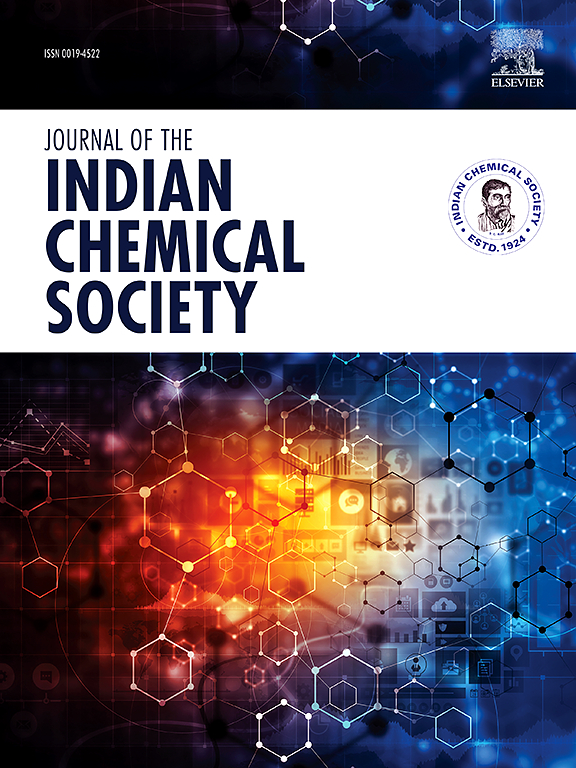探索Li和Na共掺杂SnS材料的物理和电学性质
IF 3.2
4区 化学
Q2 CHEMISTRY, MULTIDISCIPLINARY
引用次数: 0
摘要
本研究探讨了Li (1 at%,固定)和Na (1 at%, 2 at%和3 at%)共掺杂对水热法合成的SnS材料的物理、光学和电性能的影响。作为一种硫系化合物,SnS是一种储量丰富、具有成本效益的材料,与GeS、PbS、GeTe和PbTe等类似化合物相比,其毒性较低。值得注意的是,硫化锡(SnS)由于其独特的层状结构和非谐波键合而具有巨大的储能应用潜力。所有样品的相纯度均通过粉末XRD图确定,与标准JCPDF文件(PDF# 075-2115)一致。使用场发射扫描电子显微镜(FESEM)评估表面形貌,而能量色散x射线(EDX)分析提供了对样品化学成分和元素分布的见解。紫外可见吸收光谱显示,与裸露的SnS样品相比,Li和Na共掺杂的SnS样品的带隙值降低了,从Tauc图中可以确定,Li (1 at%,固定)和Na (3 at%)共掺杂的SnS样品的带隙值最小达到1.30 eV。通过红外光谱研究了样品中的化学键和官能团,并通过热重分析(TGA)评价了样品的热稳定性。为了评估电学特性,在室温(305 K)下进行霍尔效应测量,确认了所有样品的p型半导体行为。在所测试的组合物中,Li (1 at%,固定)和Na (3 at%)共掺杂的SnS样品表现出最高的载流子浓度(n = 6.57 × 1018 cm−3)和优越的电导率(0.22 S/cm),优于裸样品和其他共掺杂样品。本文章由计算机程序翻译,如有差异,请以英文原文为准。
Exploring the physical and electrical properties of Li and Na Co-doped SnS material
This study explores the effect of Li (1 at%, fixed) and Na (1 at%, 2 at%, and 3 at%) co-doping on the physical, optical, and electrical performance of SnS material synthesized via a hydrothermal approach. As a chalcogenide compound, SnS is an earth-abundant, cost-effective material with lower toxicity compared to similar compounds such as GeS, PbS, GeTe, and PbTe. Notably, tin sulfide (SnS) holds great potential for energy storage applications due to its unique layered structure and anharmonic bonding. The phase purity of all the samples was confirmed through powder XRD pattern, which aligned well with the standard JCPDF file (PDF#075–2115). The surface morphology was assessed using field emission scanning electron microscopy (FESEM), while energy dispersive X-ray (EDX) analysis provided insights into the chemical composition and elemental distribution of the samples. UV–Vis absorption spectroscopy showed a reduction in the band gap value of Li and Na co-doped SnS compared to the bare SnS sample, reaching a minimum of 1.30 eV for the Li (1 at%, fixed) and Na (3 at%) co-doped SnS sample, as determined from the Tauc plot. The chemical bonds and functional groups present in the samples were explored via FTIR spectroscopy, and the thermal stability was evaluated through thermogravimetric analysis (TGA).
To assess the electrical characteristics, Hall Effect measurements were performed at room temperature (305 K), confirming p-type semiconducting behavior of all the samples. Among the tested compositions, the Li (1 at%, fixed) and Na (3 at%) co-doped SnS sample exhibited the highest carrier concentration (n = 6.57 × 1018 cm−3) and superior electrical conductivity (0.22 S/cm), outperforming both bare and other co-doped samples.
求助全文
通过发布文献求助,成功后即可免费获取论文全文。
去求助
来源期刊
CiteScore
3.50
自引率
7.70%
发文量
492
审稿时长
3-8 weeks
期刊介绍:
The Journal of the Indian Chemical Society publishes original, fundamental, theorical, experimental research work of highest quality in all areas of chemistry, biochemistry, medicinal chemistry, electrochemistry, agrochemistry, chemical engineering and technology, food chemistry, environmental chemistry, etc.

 求助内容:
求助内容: 应助结果提醒方式:
应助结果提醒方式:


